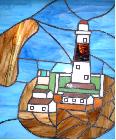
|
Beranger by Peter Harbison |
Iona Airways by Pearse Cahill |
|
18th. Century Antiquarian Sketches of Co. Dublin |
|
Peter Harbison provided a most enjoyable and interesting evening for those present at the S.H.S. January meeting. The topic was Beranger's views of County Dublin in the 18th. century. Mr. Harbison took us on a tour of, mainly South Co. Dublin, where most of the drawings come from, and illustrated the lecture with slides of many of the beautiful drawings. The views were of a landscape that has irrevocably disappeared. Beranger was born in Amsterdam of French Hugenot Parents in about 1730. Mr. Harbison showed a self portrait of Beranger - it appeared in the Journal of the Royal Society of Antiquaries about 1870. He was a very elegant man dressed in typical 18th. century style. We know Beranger's work essentially because his patron was a man who paid him over the years to go and produce quite a lot of drawings. That patron was Colonel William Burton, who was born in Co. Clare and inherited Slane Castle and then had to take on the family name, which is Conyngham and in fact the present Lord Mountcharles is a collateral descendant. Burton Conyngham was the prime mover in the Hibernian Antiquarian Society, which he founded in 1779. The purpose of this Society was to go and extol the virtues of Ireland's antiquarian and architectural heritage. The idea was that Beranger was to be employed to do sketches and prepare a volume of engravings to compete with the ones of England and Wales and show off the beauties of Ireland's ancient monuments. Burton Conyngham had already collected a group of sketches and drawings which Beranger was employed to copy. |
Many of the drawings that he did himself were intended to be used in this famous volume of engravings which was Burton Conyngham's idea, but unfortunately because there were internal wranglings, the Society folded after about four years without the volume of engravings ever having appeared. However the efforts of Burton Conyngham were not in vain because Ledwidge got hold of - with Burton Conyngham's permission - all the drawings which Burton Conyngham had in his portfolio and then used those himself in the two volumes of engravings which we know as Grose's Antiquities. Most of what we know of the antiquities of Ireland is from this source but you should think of Beranger as well. When Beranger died in 1817 his name just went into oblivion. We owe our knowledge of Beranger to none other than Sir William Wilde who gave us an account of Beranger's work in a series of articles with the title of "The Labours of Gabriel Beranger in the Art of History …. etc." Wilde had at his disposal a diary which Beranger had kept throughout his various travels. Unfortunately this diary has got lost and Mr. Harbison asked those present "if any of you happen to know where it is tell me because I would dearly love to be able to lay my hands on it". We await developments! Mr. Harbison has attempted to do what Wilde wanted to do in the 19th. century and he did that in two books - Beranger's Antique Buildings of Ireland and Beranger's Views of Ireland which are in part publications of two albums of Beranger drawings, one from the National Library and the other from the Royal Irish Academy. |